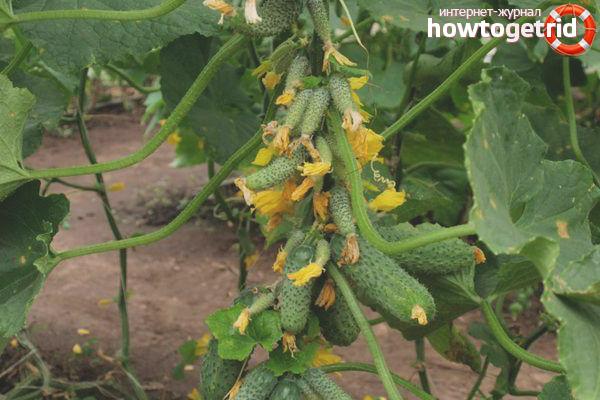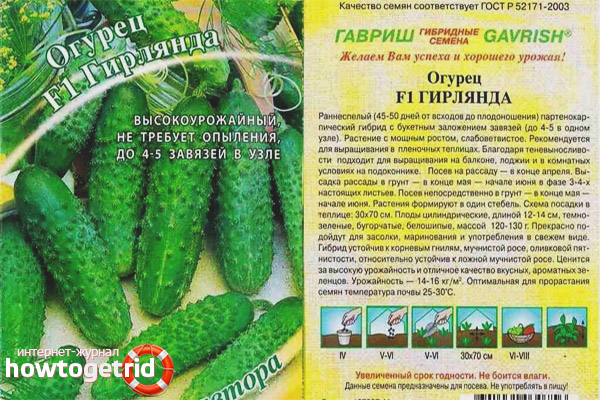The content of the article
The variety of cucumbers Garland F1 enjoys well-deserved popularity among buyers. Creating this hybrid, breeders preserved the best qualities of parental varieties in it, trying to remove all their shortcomings. The result of this work was that the hybrid is characterized by unpretentiousness in cultivation, immunity to most diseases and a very high yield, as well as high taste characteristics of the fruit.
Brief description of the variety
Variety Garland F1 - early ripening, from the moment when the first sprouts of a cucumber hatch, it takes about 35-45 days to harvest the first crop. The variety belongs to the parthenocarpic type, that is, its flowers do not need pollination. This is a unique property for cucumbers that are grown in greenhouses or in any room closed to insect pollinating cucumber flowers.
The variety is distinguished by a strong thick stem with powerful growth. The branching intensity is low, as in most early ripening varieties. Lateral shoots are weakly formed, which allows for a more dense planting of bushes on the bed and does not require frequent pinching. The main lash grows long, providing increased productivity. The leaves are densely green in color, small in size, have denticles along the edges and resemble the shape of a heart.
The ovaries of the Garland F1 - a bouquet type. In the axils of the stem 3-5 cucumbers are formed, and if the plant is created under especially favorable conditions, the number of ovaries can be up to 10 pieces. The yield of the variety is quite high, about 35 fruits can ripen at the same time on each bush. With the standard arrangement of bushes on the plantation, one square meter gives up to 14-16 kilograms of cucumbers.
Fruit Description
Application
The use of cucumbers Garland F1 is quite universal. They are consumed raw, they can be a very tasty ingredient in summer salad or a plate with fresh vegetables. They are good in pickling, and marinades, and in all kinds of other canned goods.
Cucumbers are very strong, they perfectly tolerate storage and transportation, which allows them to grow for commercial purposes.
Growing Features
Like all partenocarpic varieties of cucumbers, the F1 Garland hybrid is intended for cultivation, primarily in greenhouses. Its plants are not demanding on sunlight, so they can be placed in shady areas, on the balcony, indoors on the windowsill. The only requirement is that the temperature does not fall below 25 degrees.
When growing by seedlings, seeds for seedlings are sown at the end of April in containers with fertile soil. For the convenience of seed germination, you can use peat cups or tablets - one seed per each. The temperature regime for seed germination is required at least +27 degrees, but when the first leaves appear on the sprouts, it must be lowered to + 21- + 23 degrees so that the stems of the plants do not stretch excessively upwards, develop strong and powerful.
Seedlings are moved to a permanent place in the second half of May or in the first decade of June, after the formation of 3-5 true leaves. At the same time, seeds are sown with the method of growing directly on the beds.To obtain high yields, it is useful to plant cucumbers on beds after growing tomatoes, cabbage, onions, potatoes and celery on them. But the soil on which melons, watermelons, pumpkins, squash or squash were grown last year will not be very favorable for cucumbers.
Bushes are planted in the ground at intervals of 30 to 70 cm, the seeds are buried by 1-2 cm. Usually they are initially covered with a coating, which makes them unnecessary to soak before planting. The tall main stem, characteristic of the F1 Garland hybrid, requires a mandatory and competent garter, which begins after 3-5 days after transplanting the seedlings into the ground. Standard trellises are best suited for these purposes. Its construction begins with the installation of support pillars with a height of 1.8 to 2.2 meters. Then they attach a wire with a diameter of 4-5 mm in cross section, usually in two rows, directing it along the beds. Cucumber whips are tied to a wire with a twine of 3-4 mm cross-section. The twine is pulled to such an extent that it does not sag, but does not pull the stem up. However, you can use the purchased trellis, made entirely of wooden battens.
In any case, the use of trellis is of great importance, they do not allow plants to come into contact with the ground, thereby protecting them from rot, providing more sunlight, and thereby reduce disease and increase yield. The breeders who created the F1 Garland hybrid were able to give it resistance to many diseases. In particular, root rot, powdery mildew, olive spotting and, to a large extent, downy mildew are not afraid of the variety.
Care

Since parthenocarpic cucumbers do not have hollow flowers and fruits are tied on all flowers, the plants of the Garland F1 variety need special formation - they are pinched at a height of about two meters, and no shoots or flowers are left to the level of the first five leaves, removing them from the axils of the leaves . This makes the main stem more powerful, ensuring the proper development of the plant and allowing the use of all its forces for abundant fruiting.
Of other agricultural activities, the variety needs regular loosening of the soil, which ensures aeration of the root system and prevents the soil from drying out. As weeds appear, they are weeded to prevent the loss of beneficial minerals from the soil. Watering cucumbers should be carried out regularly, mainly in the morning, with warm water under the root of the plants.
The opinion of gardeners
Gardeners more and more like this "bouquet" type of cucumber hybrids. Recognizing that it still requires good dressing and proper care, many people note an excellent harvest and excellent quality of fruits - elegant, tasty and strong cucumbers of the same size. Many respondents to the polls are impressed by such agrotechnical features of the variety as undemanding to sunny color, non-susceptibility to many diseases, early ripening of fruits and long-term fruiting.
Video: cucumbers varieties Garland F1











Submit